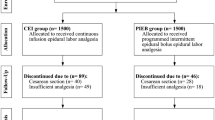Abstract
Purpose
To test the hypothesis that patient-controlled epidural analgesia (PCEA) using ropivacaine and fentanyl provides better maternal satisfaction and less anesthetic requirement than conventional continuous epidural infusion (CEI) during labor, we studied 58 uncomplicated parturients (singleton, vertex presentation).
Methods
After establishing effective epidural analgesia with 11 ml of 0.2% ropivacaine, all parturients were randomly divided into one of two groups: the PCEA group (n = 29) or the CEI group (n = 29). In the PCEA group, the pump was initiated to deliver a basal infusion at 6 ml·h−1 and a demand dose of 5 ml; the lockout interval was 10 min, and there was a 31 ml·h−1 limit. The drugs used were 0.1% ropivacaine + fentanyl 2 µg·ml−1. In the CEI group, epidural analgesia was maintained with the same solution as the PCEA group at a constant rate of 10 ml·h−1. If parturients requested additional analgesia in the CEI group, we added 8 ml of epidural 0.2% ropivacaine without fentanyl.
Results
Parturients’ demographic data, such as duration of labor, mode of delivery, Apgar score, and umbilical arterial pH did not differ between the two groups. However, the hourly requirement of ropivacaine was significantly less in the PCEA group than in the CEI group (9.3 ± 2.5 vs. 17.6 ± 7.6 mg·h−1; P < 0.05). Parturients’ satisfaction assessed by the Visual Analogue Scale tended to be higher in the PCEA group than in the CEI group. Side effects such as nausea, hypotension, and itching were similar for the two groups.
Conclusion
We found that PCEA was an effective means of providing optimal analgesia, with better satisfaction during labor and less local anesthetic requirement.
Similar content being viewed by others
References
DR Gambling P Yu C Cole GH McMorland L Palmer (1988) ArticleTitleA comparative study of patient controlled epidural analgesia (PCEA) and continuous infusion epidural analgesia (CIEA) during labour Can J Anaesth 35 249–254
MD Owen JA Thomas T Smith LC Harris R D’Angelo (2002) ArticleTitleRopivacaine 0.075% and bupivacaine 0.075% with fentanyl 2 µg/ml are equivalent for labor epidural analgesia Anesth Analg 94 179–183
MD Owen R D’Angelo JC Gerancher JM Thompson ML Foss JD Babb JC Eisenach (1998) ArticleTitle0.125% Ropivacaine is similar to 0.125% Ropivacaine for labor analgesia using patient-controlled epidural infusion Anesth Analg 86 527–531
NP Chua AT Sia CE Ocampo (2001) ArticleTitleParturient-controlled epidural analgesia during labour: bupivacaine vs. ropivacaine Anaesthesia 56 1169–1173
GC Meister R D’Angelo M Owen KE Nelson R Gaver (2000) ArticleTitleA comparison of epidural analgesia with 0.125% ropivacaine with fentanyl versus 0.125% bupivacaine with fentanyl during labor Anesth Analg 90 632–637
SH Halpern TW Breen DC Campbell HA Muir J Kronberg R Nunn GH Fick (2003) ArticleTitleA multicenter, randomized, controlled trial comparing bupivacaine with ropivacaine for labor analgesia Anesthesiology 98 1431–1435
FM Ferrante L Lu SB Jamison S Datta (1991) ArticleTitlePatient-controlled epidural analgesia: demand dosing Anesth Analg 73 547–552
DR Gambling CJ Huber J Berkowitz P Howell JE Swenerton PLE Ross CT Crochetière TJG Pavy (1993) ArticleTitlePatient-controlled epidural analgesia in labour: varying bolus dose and lockout interval Can J Anaesth 40 211–217
FM Ferrante FA Rosinia C Gordon S Datta (1994) ArticleTitleThe role of continuous background infusions in patient-controlled epidural analgesia for labor and delivery Anesth Analg 79 80–84
PD Curry C Pacsoo DG Heap (1994) ArticleTitlePatient-controlled epidural analgesia in obstetric anaesthetic practice Pain 57 125–127
AT Sia JL Chong (1999) ArticleTitleEpidural 0.2% ropivacaine for labour analgesia: parturient-controlled or continuous infusion? Anaesth Intensive Care 27 154–158
SL Eriksson C Gentele CH Olofsson (2003) ArticleTitlePCEA compared to continuous epidural infusion in an ultra-low-dose regimen for labor pain relief: a randomized study Acta Anaesthesiol Scand 47 1085–1090
AT Sia P Ruban JL Chong K Wong (1999) ArticleTitleMotor blockade is reduced with ropivacaine 0.125% for parturient-controlled epidural analgesia during labour Can J Anesth 46 1019–1023
JD Vertommen E Vandermeulen H Van Aken L Vaes M Soetens A Van Steenberg P Mourisse J Willaert H Noorduin H Devlieger AF Van Assche (1991) ArticleTitleThe effects of the addition of sufentanyl to 0.125% bupivacaine on the quality of analgesia during labor and on the incidence of instrumental deliveries Anesthesiology 74 809–814
CH Olofsson A Ekblom G Ekman-Ordeberg L Irestedt (1998) ArticleTitleObstetric outcome following epidural analgesia with bupivacaine-adrenaline 0.25% or bupivacaine 0.125% with sufentanil: a prospective randomized controlled study in 1000 parturients Acta Anaesthesiol Scand 42 284–292
HJ Lacassie MO Columb HP Lacassie RA Lantadilla (2002) ArticleTitleThe relative motor blocking potencies of epidural bupivacaine and ropivacaine in labor Anesth Analg 95 204–208
NB Kenepp BB Gutsche (1981) ArticleTitleInadvertent intravascular injections during lumber epidural anesthesia Anesthesiology 54 172–173
BL Leighton MC Norris CA DeSimone T Rosko JB Gross (1990) ArticleTitleThe air test as a clinically useful indicator of intravenously placed epidural catheters Anesthesiology 73 610–613
MC Norris ST Fogel H Dalman S Borrenpohl W Hoppe A Riley (1998) ArticleTitleLabor epidural analgesia without an intravascular “test dose.” Anesthesiology 88 1495–1501
MC Norris D Ferrenbach H Dalman ST Fogel S Borrenpohl W Hoppe A Riley (1999) ArticleTitleDoes epinephrine improve the diagnostic accuracy of aspiration during labor epidural analgesia? Anesth Analg 88 1073–1076
SZ Lysak JC Eisenach CE Dobson (1990) ArticleTitlePatient-controlled epidural analgesia during labor: a comparison of three solutions with a continuous infusion control Anesthesiology 72 44–49
BB Lee WD Ngan Kee Ff Ng TK Lau ELY Wong (2004) ArticleTitleEpidural infusions of ropivacaine and bupivacaine for labor analgesia: a randomized, double-blind study of obstetric outcome Anesth Analg 98 1145–1152
RE Collis FS Plaat BM Morgan (1999) ArticleTitleComparison of midwife top-ups, continuous infusion and patient-controlled epidural analgesia for maintaining mobility after a low-dose combined spinal-epidural Br J Anaesth 82 233–236
M Van der Vyver S Halpern G Joseph (2002) ArticleTitlePatient-controlled epidural analgesia versus continuous infusion for labour analgesia: a meta-analysis Br J Anaesth 89 459–465
Author information
Authors and Affiliations
About this article
Cite this article
Saito, M., Okutomi, T., Kanai, Y. et al. Patient-controlled epidural analgesia during labor using ropivacaine and fentanyl provides better maternal satisfaction with less local anesthetic requirement. J Anesth 19, 208–212 (2005). https://doi.org/10.1007/s00540-005-0316-2
Received:
Accepted:
Issue Date:
DOI: https://doi.org/10.1007/s00540-005-0316-2




